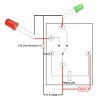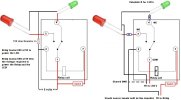Hi, i have made up some simple red/green signal lights using some 5mm led's on 5 volts with both negatives connected to a single 150ohm resistor, leaving 5v going to one or the other positive led leads. On all of them, the green led is perfect, but the red led is noticeably dimer. Any suggestions as i assumed the red & green have the same values ??. Thanks.




